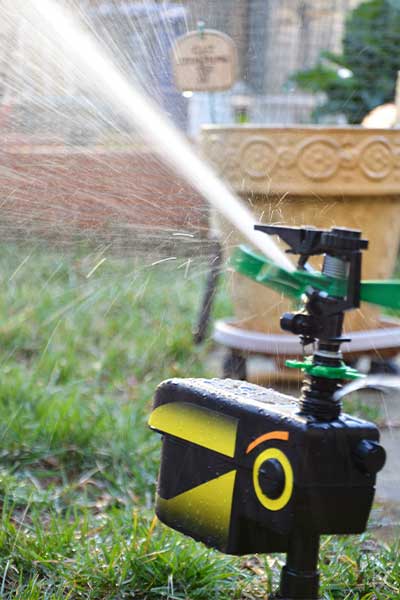Blog: Responding to complaints about community cats
Neighborhood Cats co-founder shares how to keep the peace between community cats and their human neighbors
August 10, 2022

When I first started helping community cats, I fed a colony that inhabited the inner courtyards of a city block on the Upper West Side of Manhattan. The first year, a local business gave me and a few other volunteers access to the courtyards through their garage. We were able to trap and feed the cats in the business’s private backyard without anyone in the neighborhood much noticing.
But the second year, we lost our access thanks to an empty, very smelly cat food can left in the trash inside the garage. I soon found myself feeding the cats through a wrought iron fence bordering an empty, grassy lot, in full view of anyone walking along the sidewalk.
One afternoon, as I used an arm extender to push the bowls further into the lot and out of reach of passersby, a man came rushing over, eyes ablaze, clearly ready to do battle. “Ugh, here we go,” I thought, tensing up.
Sure enough, he started berating me about the cats and how irresponsible I was to maintain them there and who was I to invade his home (he lived in the building bordering the lot). Rather than argue, I stood there and let him rant. When he reached a lull, I asked, “What exactly is it about the cats that’s bothering you?”
It turned out that his bedroom window overlooked the lot, and the cats fighting at night and the females caterwauling prevented him from getting a decent night’s sleep.
“Yeah, that’s pretty bad,” I said. “I wouldn’t like it if the cats kept me up either.”
Once I said this, he calmed down, giving me the chance to describe how I’d discovered the colony and was in the process of getting them spayed and neutered, that I’d already removed a number of kittens, and that once the remaining cats were fixed, the noise at night would dramatically lessen or even disappear.
When I finished explaining my trap-neuter-return project, the guy shook my hand and thanked me for providing a service to the community.
De-escalate confrontation
During this encounter, I used a three-step process for handling confrontation:
Step 1: Listen. People need to vent, to feel like they’re being heard. If you argue instead of listening, you cut them off, fail to acknowledge what they consider to be legitimate grievances and make it more likely the conflict will escalate.
If you can genuinely put yourself in someone else’s place and show it, then you’re no longer opponents: You’re just two people considering a problem.
Step 2: Empathize. See their perspective and, if it’s at all reasonable, express understanding rather than try to argue them out of how they feel. If you can genuinely put yourself in someone else’s place and show it, then you’re no longer opponents: You’re just two people considering a problem.
Step 3: Offer solutions. Now that the conflict has been de-escalated and the other person sees you’re trying to help, they’ll be more open to what you have to say.
This process can also be applied in a group setting, such as a homeowner association meeting or a community board discussion. There’s no guarantee the approach will work every time with everyone, but it gives you an opportunity to turn things around. Remember, if you get mad and both of you walk away angry, where does that leave the cats?
Explain the fix
Simply getting the cats sterilized resolves many of the gripes people have about community cats, but since the average person won’t know this, you should be prepared to explain how it works.
For example, most of the noise associated with outdoor cats is related to mating behavior, including male cats fighting and females vocalizing when they’re in heat. Remove the sex drive, and the noise goes away.
Another common complaint is the noxious smell left by an intact male spraying to mark his territory. Testosterone becomes mixed with the tom’s urine and creates the foul odor. Neutering eliminates that.
If someone is bothered by the cats’ presence in general, their visibility is much lower post-neutering because so much of their roaming is related to mating. I was part of a large TNR project at a jail situated on 400 acres. Afterwards, officers used to seeing cats all over the place would ask what we did with them, not realizing most had been returned.

Prevent run-ins
Of course, conflicts can arise over altered cats, too. Some people don’t want the cats on their property for whatever reason—their kid is allergic, the cats frighten their dog, they’re concerned about the poop or they just don’t like cats. Instead of arguing that the cats have the right to roam where they want, you can work with the property owner to keep the cats away.
Here are some useful tools for deterring cats from places where they’re not welcome:
Motion-activated sprinklers. This is our favorite deterrent at Neighborhood Cats. The device emits an infrared field covering an average backyard and is connected to a hose. When an animal the size of a cat enters the field, the device shoots out a burst of water. It doesn’t actually get the cats wet, but it does frighten them.
Before long, the cats learn the boundaries of the infrared field and avoid entering it. (If you’re in a cold weather climate, you’ll want to set up the sprinkler during a warm season so the cats are trained before the temperatures are low enough for the water in the hose to freeze.)
Motion-activated ultrasonic devices. These devices also emit an infrared field and produce a high-pitched sound that’s inaudible to humans but highly annoying to cats. Most cats will go away soon after they hear it, although the more stubborn among them may take a couple of weeks before their irritation level prods them to vacate the yard.
There are a variety of ultrasonic devices to choose from, including models that are friendly to birds, include strobe lights or are solar-powered. The sound waves don’t penetrate solid objects, so you needn’t worry about disturbing indoor cats or any felines on the other side of the fence. However, to be effective, the devices must be placed properly, and it’s easy to make mistakes.
Cat-proof fencing. Many products intended to keep cats inside yards can be used to keep cats out of locations, too. There are free-standing fencing options and products you attach to an existing fence. Many commercial cat-fencing products consist mostly of netting the cats can’t scale, but one company, Oscillot, uses rolling bars installed on top of existing fences. When cats try to scale the fence, they’ll grab onto the bar, which then spins and forces them to jump back down. (This works best in warm weather climates where there’s no risk of the rolling bars freezing in place.)
Garden deterrents. Some people don’t mind cats on their property in general but strongly object to cats visiting their gardens. The ability to dig and bury their waste is what attracts cats to gardens, and so the solution is to make it difficult or unpleasant to dig there. Cover open ground with river rocks, lay down lattice fencing and plant seeds in the openings, or use a Cat Scat Mat, which consists of rows of plastic spikes pointing upwards. Press the mat into the ground, and it will deter a cat from digging or walking over it (it doesn’t harm them).
Another option is to give the cats a more inviting place to do their business. A sandbox or a pile of peat moss in the corner of the yard can do the trick, and you can easily replace the sand or peat moss as needed.

Be the peacekeeper
As useful as deterrents can be for resolving conflicts, caretaking practices can go a long way to preventing conflict in the first place. Probably the most common complaint when it comes to community cats is unsightliness of feeding locations—empty cans, paper plates, plastic containers, excess food, etc. You can forestall complaints by placing a feeding station in a discreet place and keeping the site clean, including picking up trash whether you put it there or not. To avoid attracting rodents and other wildlife, train the cats to eat at a certain time of day and put out only as much as they’ll consume before you depart.
For every complaint about community cats, there’s usually a solution. Cats stalking birds? Help the neighbor pick a spot for the bird feeder that cats can’t easily reach, at least not without clearly showing themselves, and away from bushes where a cat could hide.
Are fleas the problem? If the cats will allow you close enough, treat them periodically with a topical medication that provides 30 days of protection, or put Capstar or the generic equivalent in their food, making sure each cat gets the correct dosage. Spread diatomaceous earth (food-grade only) in cracks of walls or other spots favored by fleas. It kills them on contact but is harmless to cats and other critters (just be sure to wear a dust mask when applying it). If fleas in a grassy area are the problem, apply beneficial nematodes to the lawn.
Community cat advocates are a creative bunch, and a little research will typically turn up a way to resolve whatever is causing conflict. Be the peacemaker—the cats will thank you for it!

